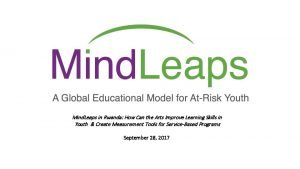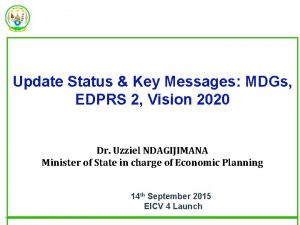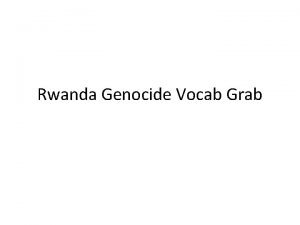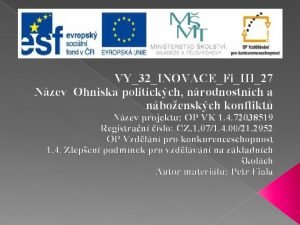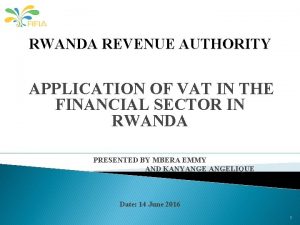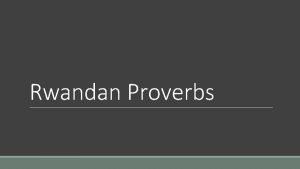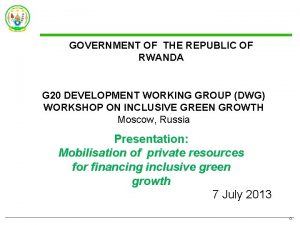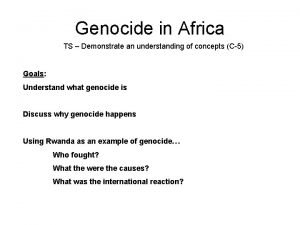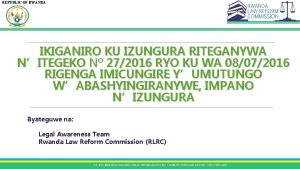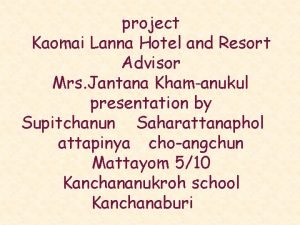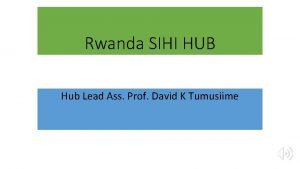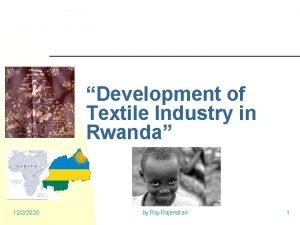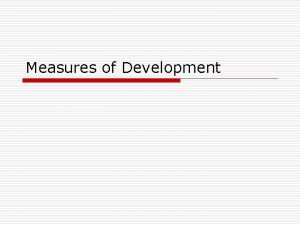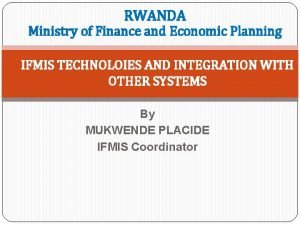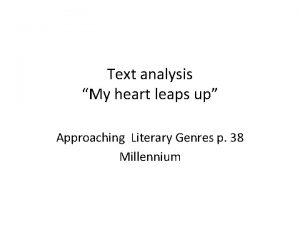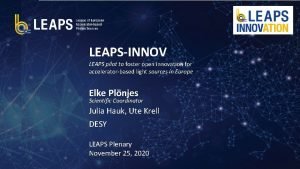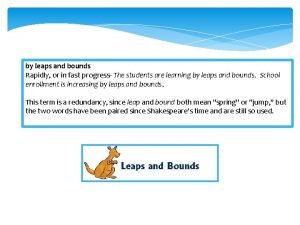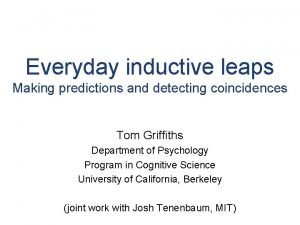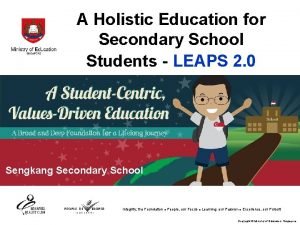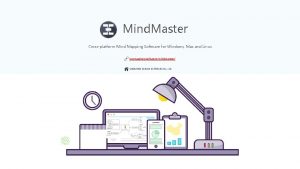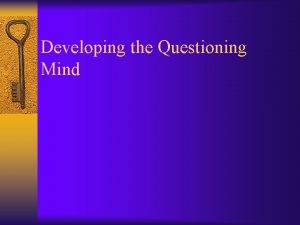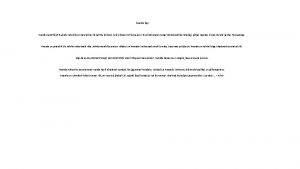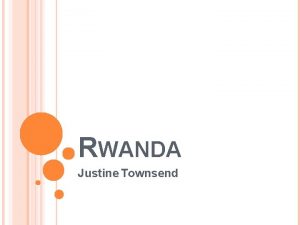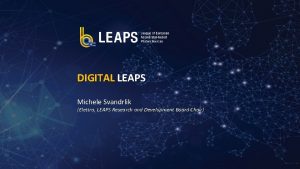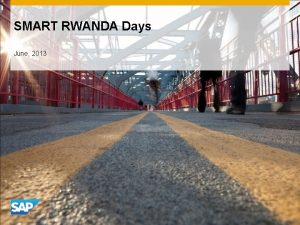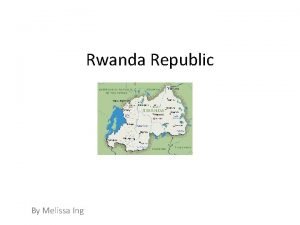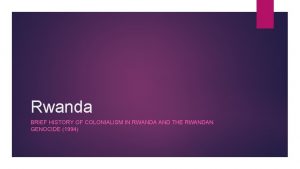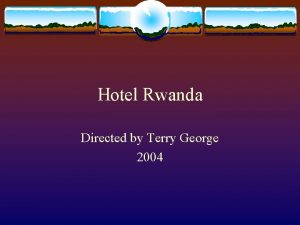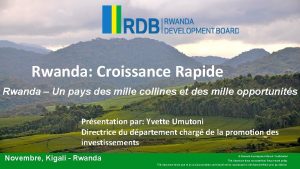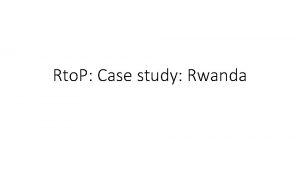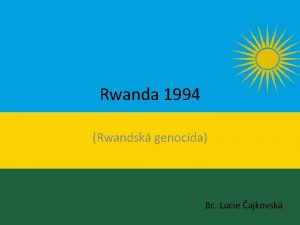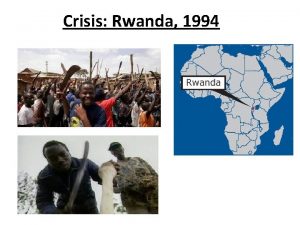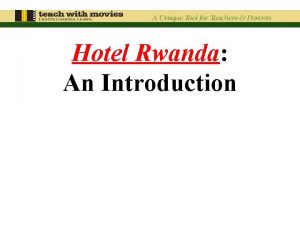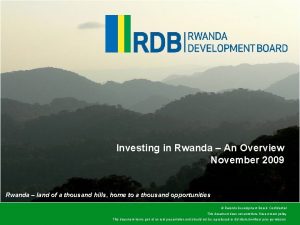Mind Leaps in Rwanda How Can the Arts


































- Slides: 34

Mind. Leaps in Rwanda: How Can the Arts Improve Learning Skills in Youth & Create Measurement Tools for Service-Based Programs September 28, 2017

Contact Information Rebecca Davis Executive Director, Mind. Leaps Janelle Junkin, Ph. D, MT-BC Co-Founder, unlock Ngenuity davis@mindleaps. org 1 -215 -840 -3890 jsj 323@gmail. com 1 -215 -888 -1708



Successful at Memorization?

What does it mean to be a Mind. Leaps student? Dance Program • • • 6 hours/week Minimum of 12 weeks Ages 9 – 18 years Boys & Girls Taught by trained local Mind. Leaps instructors Outcome: Improved cognitive skills & SEL for school and the workplace




Cognitive & Non-Cognitive Skills Memorization Language Grit Discipline (“Respect & Tolerance”) Creativity Self-Esteem Teamwork


Controlling Grader Bias All children, in all programs, are assessed using the developed skill rubric by trained graders. To control for bias, multiple graders grade simultaneously comparing scores. Ongoing training is provided for graders. Graders train new graders. Scores are reviewed in data analysis to determine if and what discrepancies and if possible bias are present.

Assessing Cognitive & Non-Cognitive Skills • Problems Identified • Culturally appropriate. • Non-verbal (most children are illiterate). • Able to be administered by trained local staff. • Problems Solved • Panga Munthu Test (PMT). • Pending Solutions • Seeking a similar non cognitive assessment to OCEAN that can be used non-verbally. External Skill Assessment Validation

Panga Munthu Test compared to Memorization Score (2014 -2016) Memorization Male Child Group A (115 - ID) 105 Frequeny of Score(over time) 85 65 45 25 5 1 -15 Male Child Group A (105 - ID) 2 3 4 5 Likert Scale 105 115 6 7

Methodology

Girls Scores in Grit in Rwanda

Case Study: Street Children as Researchers in Rwanda

Participatory Action Research (PAR) – Selectivity Bias Question: Are the children in Mind. Leaps representative of out of school street children in an urban slum? PROBLEM: How are we going to gather the information needed from children not involved in Mind. Leaps?

Steps Leading to PAR Survey Method 1. Researchers determined the questions for the survey. 2. Survey given to translator. 3. Survey returned in Kinyarwanda with translation. 4. Survey piloted with 4 street children who further refined the questions. 5. Four street children trained in data collection – 172 completed surveys of street children, not in Mind. Leaps.


Implementation • Collecting data on street children provided the opportunity to actively engage street children in the data collection process. • Four Mind. Leaps children were identified • All were trained in the survey and data collection protocol. Participatory Action Research Implementation & Outcomes Outcome • All data collectors returned completed surveys for review and refinement of the data collection process. • One child expressed an interest in becoming a researcher in the future. • All experienced mastery.

Selectivity Bias Result The children at Mind. Leaps are representative of out of school youth. This verifies that the Mind. Leaps’ intervention (dance program) will work with other out of school youth.

Building a Research Team 1 Identify university faculty and/or students required to complete research practicum. 2 Develop a research question (or have a question in mind). 3 Cultivate the relationship. 4 Do a literature search.

Janelle Junkin, Ph. D, MT-BC, Adjunct Professor Harrisburg University, co-founder unlock Ngenuity Patrick Mc. Sharry, Ph. D, Oxford University, Visiting Professor Carnegie Mellon University, Rwanda. Kigali Collaborative Research Center Michael Leeds, Ph. D, Professor & Chair, Department of Economics, Temple University Research Volunteers Software Engineers Mind. Leaps Research Collaboration

Mind. Leaps Research Worldview Pragmatic: knowledge and methodology have a reciprocal relationship. Multiple perspectives inform the constructed realities.

Scalability

Contact Information Rebecca Davis Executive Director, Mind. Leaps Janelle Junkin, Ph. D, MT-BC Co-Founder, unlock Ngenuity davis@mindleaps. org 1 -215 -840 -3890 jsj 323@gmail. com 1 -215 -888 -1708



The Mind. Leaps program is having an impact that is statistically significant in both boys and girls (P<0. 001). (2014 -2016) Subset Performance Change All Boys Girls Number Mean SD Median 115 71 44 0. 75 0. 64 0. 93 1. 01 0. 99 1. 04 0. 71 0. 79

Both boys and girls improved at a statistically significant rate when controlling for gender (P<0. 1). Subset Performance Change All Boys Girls Number Mean SD Median 115 71 44 0. 75 0. 64 0. 93 1. 01 0. 99 1. 04 0. 71 0. 79

RESULTS in Rwanda • 74 -80% of youth leave street life • 0% drop out rate for graduates enrolled in formal education • 700+ children have completed the dance program

Long-Term Change in Youth Class Rank in Formal Education After Mind. Leaps Program (avg class size 44) Top 10 18% 11 th-20 th 55% 27% After 20 th

Average Performance of Group over Days in Program LEGEND A = Group of 21 boys B = Group of 18 boys C = Group of 15 boys D = Group of 18 boys E = (in school) Group of 15 girls, weekend only F = (out of school) Group of 21 girls Composite Skills by Groups, Measured by number of days in program
 Mind leaps
Mind leaps Creative arts grade 8 drama worksheets
Creative arts grade 8 drama worksheets Rwanda health management information system
Rwanda health management information system Hotel rwanda recensione
Hotel rwanda recensione Aceesd rwanda
Aceesd rwanda Edprs rwanda
Edprs rwanda Cheap darfur hotels
Cheap darfur hotels Rwanda was colonized by which country
Rwanda was colonized by which country Rwanda konflikt
Rwanda konflikt Vat calculation in rwanda
Vat calculation in rwanda Umusonga english
Umusonga english Dot rwanda
Dot rwanda President paul kagame
President paul kagame Kugabana umutungo
Kugabana umutungo Rwanda genocide map
Rwanda genocide map Kaomai lanna resort
Kaomai lanna resort Lead ass
Lead ass Rwanda textile industry
Rwanda textile industry Human development index rwanda
Human development index rwanda Centrifugal force in geography
Centrifugal force in geography Bootstrappping
Bootstrappping Smart ifmis
Smart ifmis Verbal judo 8 step traffic stop
Verbal judo 8 step traffic stop Stock replacement strategy
Stock replacement strategy Verbal judo leaps
Verbal judo leaps A rainbow in the sky formalistic analysis
A rainbow in the sky formalistic analysis Leaps innov
Leaps innov Progress in leaps and bounds
Progress in leaps and bounds Xxtttxxx
Xxtttxxx Onomatopoeia in caged bird
Onomatopoeia in caged bird Holistic education singapore
Holistic education singapore Mindmaster mind mapping software
Mindmaster mind mapping software A wandering mind is an unhappy mind
A wandering mind is an unhappy mind The critical mind is a questioning mind
The critical mind is a questioning mind Thế nào là sự mỏi cơ
Thế nào là sự mỏi cơ
